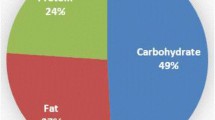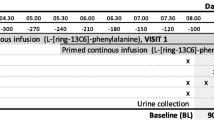Summary
Eight young men were tested for strength, anaerobic capacity and aerobic endurance in a post absorptive state and after a 3.5 day fast. Strength was tested both isokinetically (elbow flexors, 0.52 rad·s−1 and 3.14 rad·s−1) and isometrically. Anaerobic capacity was evaluated by having subjects perform 50 rapidly repeated isokinetic contractions of the elbow flexors at 3.14 rad·s−1. Aerobic endurance was measured as time to volitional fatigue during a cycle ergometer exercise at 45% \(V_{O_{2{\text{max}}} }\). Measures of \(V_{{\text{O}}_{\text{2}} }\), V E, heart rate, and ratings of perceived exertion were obtained prior to and during the cycle exercise. The 3.5 day fast did not influence isometric strength, anaerobic capacity or aerobic endurance. Isokinetic strength was significantly reduced (∼ 10%) at both velocities. \(V_{{\text{O}}_{\text{2}} }\), V E and perceived exertion were not affected by fasting. Fasting significantly increased heart rate during exercise but not at rest. It was concluded that there are minimal impairments in physical performance parameters measured here as a result of a 3.5 day fast.
Similar content being viewed by others
References
Bergland B, Hemmingsson P (1982) Effects of caffiene ingestion on exercise performance at low and high altitudes in crosscountry skiers. Int J Sports Med 3:234–236
Bergstrom J (1962) Muscle electrodes in man. Scand J Clin Lab Invest [Suppl 68]
Borg G (1970) Perceived exertion as an indicator of somatic stress. Scand J Rehabil Med 2–3:92–98
Bosco J, Greenleaf J, Bernauer E, Carol D (1975) Effects of acute dehydration and starvation on muscular strength and endurance. Acta Physiol Pol 25:411–21
Brooks M, Kaiser K (1979) Muscle fiber types: how many and what kind? Arch Neurol 23:369–379
Consolazio CF, Matoush LO, Johnson HL, Nelson RA, Krzywicki HJ (1967a) Metabolic aspects of acute starvation in normal humans. Am J Clin Nutr 20:672–683
Consolazio C, Nelson R, Johnson H, Matoush L, Krzywicki H, Isaac G (1967b) Metabolic aspects of acute starvation in normal humans: performance and cardiovascular evaluations. Am J Clin Nutr 20:684–693
Dohm GL, Becker RT, Israel RG, Tapscott EB (1986) Metabolic responses to exercise after fasting. J Appl Physiol 61:1363–1368
Durnin JV, Womersley J (1974) Body fat assessed from total body density and its estimation from skinfold thickness: measurements on 481 men and women aged from 16–72 years. Br J Nutr 32:77–97
Essen-Gustavsson B, Henricksson J (1983) Enzyme profiles in Type I, IIA and IIB fiber population of human skeletal muscle. In: Knuttgen HG, Vogel JA, Poortmans J (eds) Biochemistry of exercise. Human Kinetics Publishers, Inc., Champaign, Ill., pp 447–452
Evans WJ, Winsmann FR, Pandolf KB, Goldman RF (1980) Self-paced hard work comparing men and women. Ergonomics 23:613–621
Gleser MA, Vogel JA (1973) Endurance capacity for prolonged exercise on the bicycle ergometer. J Appl Physiol 34:438–442
Gollnick PD, Piehl K, Saltin B (1974) Selective glycogen depletion pattern in human muscle fibers after exercise of varying intensity and at varying pedalling rates. J Physiol 241:45–57
Hagenfeldt L (1979) Metabolism of free-fatty acids and ketone bodies during exercise in normal and diabetic man. Diabetes [Suppl 1] 28:66–70
Henschel A, Taylor H, Keys A (1954) Performance capacity in acute starvation with hard work. J Appl Physiol 6:624–633
Hultman E, Bergstrom J (1967) Muscle glycogen synthesis in relation to diet studied in normal subjects. Acta Medica Scand 182:109–117
Keys A, Brozek J, Henschel A, Mickelsen O, Taylor HL (1950) The Biology of human starvation. U. Minnesota Press, Minneapolis, pp 3–33
Knapik JJ, Ramos M (1980) Isokinetic and isometric torque relationships in the human body. Arch Phys Med Rehabil 61:64–67
Knapik JJ, Wright JE, Kowal DM, Vogel JA (1980) The influence of US Army basic initial entry training on the muscular strength of men and women. Aviat Space Environ Med 51:1086–1090
Lategola MT (1965) The effect of 5-day, complete starvation on cardiopulmonary functions of aerobic work capacity and orthostatic tolerance. Fed Proc 24:590
Levine L, Evans WJ, Winsmann RR, Pandolf KB (1982) Prolonged self-paced hard physical exercise comparing trained and untrained men. Ergonomics 25:393–400
Murphy M, Knapik JJ, Vogel JA, Drews FR (1984) Relationship of anaerobic power capacity to performance during a 5 day sustained combat scenario. US Army Research Institute of Environmental Medicine, Natick, MA. Technical Report No T5/84
Nagle FJ (1973) Physiological assessment of maximal performance. In: Wilmore E (ed) Exercise and sports science reviews. Academic Press, New York, pp 313–338
Owen OE, Felig P, Morgan AP, Wahren J, Cahill GF (1969) Liver and kidney metabolism during prolonged starvation. J Clin Invest 48:574–583
Pozefsky T, Tancredi RG, Moxley RT, Dupre J, Tobin JD (1976) Effects of brief starvation on muscle amino acid metabolism in nonobese man. J Clin Invest 57:444–449
Ramos M, Knapik JJ (1978) Instrumentation and techniques for the measurement of muscular strength and endurance in the human body. US Army Research Institute of Environmental Medicine, Natick, MA, Technical Report No T2/80
Russell DM, Leiter LA, Whitwell J, Marliss EB, Jeejeebhoy KN (1983) Skeletal muscle function during hypocaloric diets and fasting: a comparison with standard nutritional assessment parameters. Am J Clin Nutr 37:133–138
Russell DM, Walker PM, Leiter LA, Sima AAF, Tanner WK, Meckle DAG, Whitwell J, Marliss EB, Jeejeebhoy KN (1984) Metabolic and structural changes in skeletal muscle during hypocaloric dieting. Am J clin Nutr 39:503–513
Taylor H, Henschel A, Mickelsen O, Keys A (1954) Some effects of acute starvation with hard work on body weight, body fluids, and metabolism. J Appl Physiol 6:613–623
Thorstensson A, Karlsson J (1976) Fatigability and fiber composition of human skeletal muscle. Acta Physiol Scand 98:318–322
Young AJ, Evans WJ, Cymerman A, Pandolf KB, Knapik JJ, Maher JT (1982) Sparing effect of chronic high altitude exposure on muscle glycogen utilization. J Appl Physiol: Respirat Environ Exercise Physiol 52:857–862
Wernerman J, Von der Decken A, Vennars E (1985) Size distribution of ribosomes in biopsy specimens of human skeletal muscle during starvation. Metabolism 34:665–669
Author information
Authors and Affiliations
Rights and permissions
About this article
Cite this article
Knapik, J.J., Jones, B.H., Meredith, C. et al. Influence of a 3.5 day fast on physical performance. Europ. J. Appl. Physiol. 56, 428–432 (1987). https://doi.org/10.1007/BF00417770
Accepted:
Issue Date:
DOI: https://doi.org/10.1007/BF00417770




